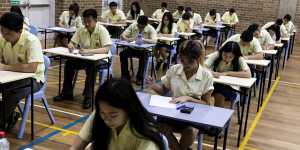Principals say increased awareness of provisions,rising anxiety among teenagers,more ADHD diagnoses and the pressures of high-stakes exams are driving some of the growth,with a record 9500 applications received across all school sectors last year.

Schools in the city’s affluent north and east suburbs are claiming almost double the HSC disability provisions than those in the west.Dominic Lorrimer
Sixty per cent of the top 20 schools that claimed HSC disability provisions last year were private,while dozens of high-fee independent schools across NSW gained provisions for at least a quarter of their students.
Some schools,including Moriah College and Glenaeon Rudolf Steiner School,had more than 35 per cent of HSC students granted special exam conditions,which can range from rest breaks to extra reading time and scribes.
In comparison,less than 2 per cent of HSC students at Cabramatta High,Parramatta High,Wiley Park Girls and Sefton High had provisions in 2021.
Secondary Principals Council head Craig Petersen said private schools often had greater access to resources that make it easier to go through the application process,including assessors,supervisors and psychologists

“Disadvantaged communities are underrepresented,and yet statistically that is where the majority of students with disabilities are. If we don’t get the allocation of provisions right it can further disadvantage students that don’t have the wherewithal to access or make applications.”
Petersen said while there were many genuine cases and needs,and more students with ADHD,anxiety and autism diagnoses,some parents try to “maximise the chances of success for their children by taking full advantage of the system.”
Chief executive of the Association of Independent Schools of NSW,Geoff Newcombe said all applications are given the same scrutiny. “Parents should be very willing to put in an application if they are concerned,” he said.
Provisions are designed to help students who wouldn’t otherwise have a fair opportunity to show what they know in the exam room,with readers or writers,extra time and standing or stretching time for those with injuries among those given.
NSW Education Authority Standards data from last year shows schools in North Sydney,the northern beaches and eastern suburbs had an average of 19 per cent of students gaining provisions,while schools in Parramatta,Blacktown,the outer south-west and outer west to blue mountains had an average of 11.5 per cent.

NESA received 9486 applications for disability provisions last year,a 9.4 per cent rise from 2020 and a record number since reporting began. Rest breaks were by far the most common provisions,with 6732 granted,followed by readers - or designated people to read the questions aloud - with 1382 given and 1095 students given extra time.
NSW Education Minister Sarah Mitchell said the application process is rigorous.
“While NESA do a good job administrating it,I will be encouraging them to make sure that all applications are in line with requirements.”
“I set out in 2019 to make sure students who needed the provisions had access to them.”
Since 2019,disability provision applications from public high schools have increased by 27 per cent,Catholic schools have increased by 28 per cent and private schools by 31 per cent. In the past two years 2700 teachers have attended online and face-to-face workshops from across the state giving advice and support about how to apply.
,the most recent review recommending a learning program to help schools navigate the application process and maximise the chance all eligible students have to apply.
At Middle Cove’s Glenaeon Steiner School principal Andrew Hill said teachers were witnessing the lingering effects of the pandemic,isolation and fractured learning.
“Students have done it particularly tough over the past two to three years during the pandemic and potentially this has bought children’s health and effort at school under the microscope more than in previous years,” he said. “We are seeing the effects of COVID and its impact on students.”
Moriah College principal Rabbi Yehoshua Smukler said provisions are rising across all schools due to a number of factors including rising levels of anxiety,diagnoses of ADHD being more prevalent,and generally more knowledge about what provisions are available for students.
“Most schools in Australia and around the world are finding that Covid has had a residual impact on students and their wellbeing and the data has highlighted that mental health and wellbeing programs for students need to be higher on our agenda.”
Australian Tutoring Association chief executive Mohan Dhall said many schools do not have the resources or psychologists and occupational therapists to do free assessments.
“Private schools often have psychologists,whereas public schools often share resources and counsellors,which means they only get part-time support and that is not enough to properly identify and see through the disability provisions for these kids. There needs to be more support for disadvantaged schools.”
The Morning Edition newsletter is our guide to the day’s most important and interesting stories,analysis and insights..